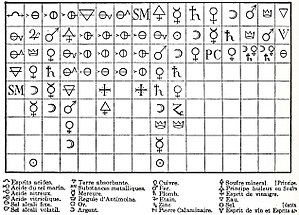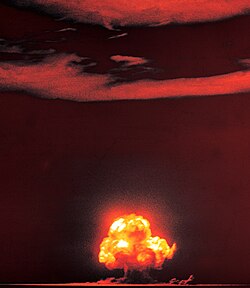Portal:History of science
The History of Science Portal
The history of science covers the development of science from ancient times to the present. It encompasses all three major branches of science: natural, social, and formal. Protoscience, early sciences, and natural philosophies such as alchemy and astrology during the Bronze Age, Iron Age, classical antiquity, and the Middle Ages declined during the early modern period after the establishment of formal disciplines of science in the Age of Enlightenment.
Science's earliest roots can be traced to Ancient Egypt and Mesopotamia around 3000 to 1200 BCE. These civilizations' contributions to mathematics, astronomy, and medicine influenced later Greek natural philosophy of classical antiquity, wherein formal attempts were made to provide explanations of events in the physical world based on natural causes. After the fall of the Western Roman Empire, knowledge of Greek conceptions of the world deteriorated in Latin-speaking Western Europe during the early centuries (400 to 1000 CE) of the Middle Ages, but continued to thrive in the Greek-speaking Byzantine Empire. Aided by translations of Greek texts, the Hellenistic worldview was preserved and absorbed into the Arabic-speaking Muslim world during the Islamic Golden Age. The recovery and assimilation of Greek works and Islamic inquiries into Western Europe from the 10th to 13th century revived the learning of natural philosophy in the West. Traditions of early science were also developed in ancient India and separately in ancient China, the Chinese model having influenced Vietnam, Korea and Japan before Western exploration. Among the Pre-Columbian peoples of Mesoamerica, the Zapotec civilization established their first known traditions of astronomy and mathematics for producing calendars, followed by other civilizations such as the Maya.
Natural philosophy was transformed during the Scientific Revolution in 16th- to 17th-century Europe, as new ideas and discoveries departed from previous Greek conceptions and traditions. The New Science that emerged was more mechanistic in its worldview, more integrated with mathematics, and more reliable and open as its knowledge was based on a newly defined scientific method. More "revolutions" in subsequent centuries soon followed. The chemical revolution of the 18th century, for instance, introduced new quantitative methods and measurements for chemistry. In the 19th century, new perspectives regarding the conservation of energy, age of Earth, and evolution came into focus. And in the 20th century, new discoveries in genetics and physics laid the foundations for new sub disciplines such as molecular biology and particle physics. Moreover, industrial and military concerns as well as the increasing complexity of new research endeavors ushered in the era of "big science," particularly after World War II. (Full article...)
Selected article -

In the history of chemistry, the chemical revolution, also called the first chemical revolution, was the reformulation of chemistry during the seventeenth and eighteenth centuries, which culminated in the law of conservation of mass and the oxygen theory of combustion.
During the 19th and 20th century, this transformation was credited to the work of the French chemist Antoine Lavoisier (the "father of modern chemistry"). However, recent work on the history of early modern chemistry considers the chemical revolution to consist of gradual changes in chemical theory and practice that emerged over a period of two centuries. The so-called scientific revolution took place during the sixteenth and seventeenth centuries whereas the chemical revolution took place during the seventeenth and eighteenth centuries. (Full article...)Selected image

This famous color photograph of the "Trinity" shot, the first nuclear test explosion, was taken by Jack Aeby on July 16, 1945. Aeby was a member of the Special Engineering Detachment at Los Alamos National Laboratory, working under the aegis of the Manhattan Project.
Did you know
...that the word scientist was coined in 1833 by philosopher and historian of science William Whewell?
...that biogeography has its roots in investigations of the story of Noah's Ark?
...that the idea of the "Scientific Revolution" dates only to 1939, with the work of Alexandre Koyré?
Selected Biography -
Muhammad ibn al-Katib Sinan al-Qunawi (died c. 1524), also known as Muhammad ibn Yusuf, was an Ottoman astronomer and muwaqqit (timekeeper) in the late fifteenth and early sixteenth century. A pioneer of Ottoman astronomy, especially in the field of astronomical instruments and timekeeping, he served as muwaqqit at various mosques, and eventually at the Sublime Porte under Suleiman the Magnificent (r. 1520–1566). He was influenced by earlier Mamluk astronomers, especially Shams al-Din al-Khalili (1320–1380) and Ibn al-Shatir (c. 1304—1375), as well as by the Central Asian Ali al-Qushji and Al-Biruni.
He wrote two treatises on the construction of the astrolabe quadrant (al-rub' al-muqantarat), including Hadiyat al-Muluk ("A Present for Kings") dedicated to Bayezid II (r. 1481–1512). He published a Turkish edition of Al-Khalili's universal tables, and compiled Mizan al-Kawakib ("Balance of the Stars"), containing tables that allow reading the time at night by observing the stars—"the most original Ottoman contribution to astronomical timekeeping by tables" according to historian of astronomy David A. King. In addition to the then commonly used Arabic, he also wrote in Turkish, in order to make his field more accessible throughout the empire. This tradition would be continued by astronomers such as Mustafa ibn Ali al-Muwaqqit. Taha Yasin Arslan writes that al-Qunawi "single-handedly pioneered" the science of timekeeping in the Ottoman Empire. (Full article...)Selected anniversaries
- 585 BC - A solar eclipse occurs, as predicted by Thales, while Alyattes is battling Cyaxares in the Battle of the Eclipse, leading to a truce. This is one of the cardinal dates on which systems of chronology can be calculated.
- 1641 - Birth of Janez Vajkard Valvasor, Slovenian polymath (d. 1693)
- 1676 - Birth of Jacopo Riccati, Italian mathematician (d. 1754)
- 1807 - Birth of Louis Agassiz, Swiss-American zoologist and geologist (d. 1873)
- 1836 - Birth of Alexander Mitscherlich, German chemist (d. 1918)
- 1872 - Birth of Marian Smoluchowski, Polish physicist (d. 1917)
- 1892 - In San Francisco, California, John Muir organizes the Sierra Club.
- 1936 - Alan Turing submits On Computable Numbers for publication.
- 1942 - Birth of Stanley B. Prusiner, American neurologist and Nobel Prize laureate
- 1980 - Death of Rolf Nevanlinna, Finnish mathematician (b. 1895)
- 2001 - Death of Francisco Varela, Chilean biologist and philosopher (b. 1946)
- 2003 - Death of Ilya Prigogine, Russian-Belgian physicist and chemist and Nobel Prize laureate (b. 1917)
Related portals
Topics
General images
Subcategories
Things you can do
Help out by participating in the History of Science Wikiproject (which also coordinates the histories of medicine, technology and philosophy of science) or join the discussion.
Associated Wikimedia
The following Wikimedia Foundation sister projects provide more on this subject:
-
Commons
Free media repository -
Wikibooks
Free textbooks and manuals -
Wikidata
Free knowledge base -
Wikinews
Free-content news -
Wikiquote
Collection of quotations -
Wikisource
Free-content library -
Wikiversity
Free learning tools -
Wiktionary
Dictionary and thesaurus









































































